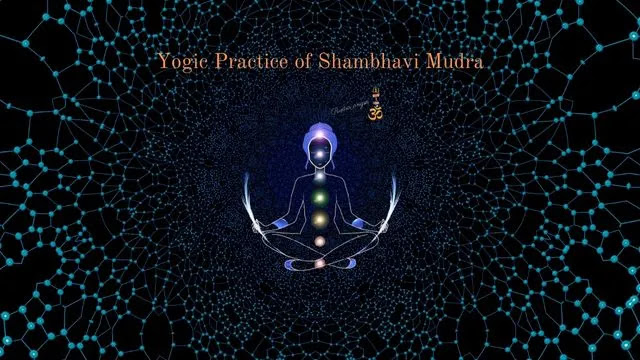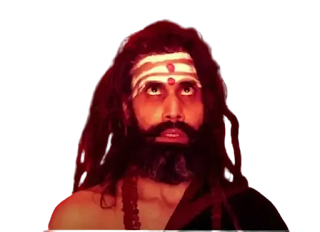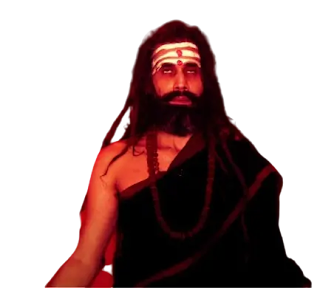The Yogic Practice of Shambhavi Mudra from Preliminary to Advance Stage
Definition of Shambhavi Mudra
The practice of Shambhavi mudra helps the practitioner to open the third eye chakra located between the eyebrows. This chakra is associated with insight, intuition, and spiritual awareness. By opening this chakra, the practitioner is said to be able to access higher levels of consciousness and gain a better understanding of the world around them.
This Mudra is an ancient meditation practice in which yogi rolls their eyeballs up and inward and fixes their gaze between the eyebrows. The site is held internally fixed while the eye is half open. It may seem that the person is seeing everything, but in reality, he is not seeing anything outside. It is said to help bring clarity and inner peace as well as help open the third eye chakra. It is often used in meditation and can be done while sitting in a comfortable position.
Shambhavi Mudra Benefits
1. Mudra is a powerful yogic technique that helps balance the mind and body and brings clarity and focus to the practitioner.
2. It helps reduce stress and anxiety and can be used as a form of meditation.
3. It helps improve concentration and focus, and can be used to help with insomnia.
4. It helps improve physical health by improving blood circulation and regulating the endocrine system.
5. It helps improve mental health by calming the mind and improving mental clarity.
6. It helps balance the three doshas in the body, which are Vata, Pitta, and Kapha.
7. It helps to open the third eye and improve insight and intuition.
8. It helps improve the connection between the physical body and the spiritual realm.
9. It helps improve the connection between the practitioner and the divine.
10. It helps improve overall well-being and can be used as a self-care.
Shambhavi Mudra Physiological Benefits
This practice is said to help reduce stress, improve concentration and bring clarity of mind. Physiologically, The Mudra is believed to help regulate the endocrine system, balance hormones, and improve nervous system function. It is also believed to help improve digestion, increase energy levels and reduce fatigue. Additionally, it helps improve blood circulation, lower blood pressure, and improve overall health.
The Basic Practice of Shambhavi mudra
Shambhavi Mudra is a practice that involves the use of eyes, breath, and body. It is said to be the most powerful of all mudras and is often used to help practitioners achieve deeper levels of meditation.
The practice of this Mudra begins with the eyes.
To begin, sit in a comfortable cross-legged position with your spine straight and eyes closed.
Place your hands in jnana mudra (finger and thumb touching) and focus your attention on the space between your eyebrows.
The eyes are closed and the gaze is directed inwards, towards the third eye chakra.
The third eye chakra is located between the eyebrows and is said to be the gateway to higher consciousness.
As the gaze is directed inward, the breath is also directed inward. It helps to create a sense of stillness and calmness in the body and mind.
Once the eyes and breath are focused inward, the practitioner begins to move the body slowly and gently. It helps to relax the body and mind and create a sense of balance and harmony. The movements are slow and rhythmic and can be done standing or sitting.
The next step is to focus the mind on the divine. This can be done by repeating a mantra or focusing on a specific image or symbol. It creates a sense of connection with the divine and helps the practitioner enter a deeper state of meditation.
The final step in the Shambhavi mudra practice is to focus the mind on the breath. Breath is used to help the practitioner be present and focus on the present moment. Breathing is also used to help the practitioner connect with God.
Repeat the exercise as many times as you like.
How Can You Enhance Your Practice to an advanced stage of Shambhavi Mudra?
1. Make sure you are in a relaxed, calm, and comfortable environment while practicing the Mudra.
2. Increase your awareness of the breath while doing this exercise. Focus on taking slow, deep breaths and really being present at the moment.
3. Visualize light entering your body through the space between your eyebrows and then gradually filling with energy and inner peace.
4. Move slowly and mindfully when transitioning from one pose to another.
5. Connect with your heart center while doing this exercise and try to hold the mudra for at least 5-10 minutes.
6. Incorporate mantra chanting or meditation music during practice to help you reach a deeper state of relaxation.
7. Practice the Mudra with other people in a group setting for a more powerful and collective experience.
8. Set an intention before starting the practice, such as the intention to release negativity or cultivate self-love.
9. Sit up straight and align your spine when starting the exercise.
10. As you close and open your eyes visualize the different colors associated with the chakras and divine energies of the universe.
11. Allow yourself to become deeply immersed in the practice and find peace in stillness and silence.
12. Follow your practice with a few moments of reflection and gratitude for what you have learned.
13. Take time to journal your insights and
14. Celebrate your practice by either making your favorite cup of tea or taking a few minutes to be in nature.
15. Take breaks when needed and don't push yourself too hard. Listen to your body and respect its needs.
Breathing Practice of Shambhavi Mudra-
1. Diaphragmatic Breathing: Focus on the downward and outward movement of your abdomen as you inhale and exhale deeply.
2. Ujjayi Breath: This breath is slightly deeper and more audible than regular breathing. Contract the back of your throat and make light sounds with each inhale and exhale.
3. Anulom Vilom: Alternate nostril breathing which not only helps to relax the body but also helps to calm the mind.
4. Bhramari: Making a humming sound while exhaling through the nose.
5. River tracing: Also known as alternate nostril breathing, this technique encourages a balance between the hemispheres of the brain.
Suggested tips help you enhance your practice of this Mudra. Please remember to be aware, take your time, and listen to your body when exercising. Also, set an intention before starting and allow yourself to surrender to the experience.
Common Mistakes to Avoid When Practicing Shambhavi Mudra?
1. Not holding the Mudra in its correct position: This Mudra is a very specific hand gesture and must be held in a specific configuration to experience its full effect. Make sure your fingertips are lightly touching and your thumb is resting between your eyebrows.
2. Making false faces: Mudra is a relaxed facial expression and should be practiced with your eyes closed. Pressing your face, trying to concentrate, or straining your eyes makes your thoughts more active, which defeats the purpose of this technique.
4. Not focusing on your breath: To get the most out of this technique, it is essential to focus on your breath while practicing mudra. Closely observe each inhale and exhale, paying attention to how the air flows in and out of your body. This will help you find a deeper level of relaxation.
5. Trying to control thoughts: Let your thoughts come and go without pushing them away or trying to control them. Don't judge yourself if your thoughts wander; Instead, bring your attention to your breath and hold the mudra. With time and practice, your ability to concentrate will improve.
6. Practicing for too long at a time: Overdoing it with Mudra can overstimulate your body and mind, leading to restlessness and anxiety. Start with a few minutes of practice and gradually increase the duration as you become more comfortable.
7. Not listening to your body: Be aware of how your body is feeling as you practice Mudra. If at any point you start to feel uncomfortable or feel any pain, stop and take a break. Don't push yourself too hard; Take it slow and listen to what your body needs.
8. Not getting the right environment: Try to practice Shambhavi Mudra in a quiet and peaceful place. Distractions around you, while you meditate, can disrupt your concentration and make it difficult to experience the effects of mudra. Make sure to find a place that is comfortable and free of distractions.
9. Forgetting to Follow Up: When your practice is over, be sure to take a few minutes to reflect on your experience and your state of mind. Noting your observations or feelings can help you understand the effects that Mudra has on your body and mind.
10. Not combining mudra with other techniques: Mudra works best when combined with other relaxation techniques or yoga postures. Consider doing some gentle poses to warm up your body before starting the mudra, and incorporate some meditation or breathing exercises afterward. This will help deepen your relaxation and maximize the benefits of your practice.
What Are the Side Effects of Practicing Shambhavi Mudra?
Some of the common side effects of practicing this Mudra include feeling sleepy or energized, a deeper sense of peace and clarity, improved focus and concentration, increased creativity, increased insight, and improved digestion. Other possible side effects include increased sweating, increased heart rate, increased body temperature, headache, nausea, dizziness, and heavy eyelids. Write More Additionally, some people may experience temporary emotional reactions such as happiness, sadness, or other intense emotions. Some people may also have minor physical discomforts such as a tingling sensation or light-headedness. In general, such sensations are considered positive and beneficial, however, if any of these sensations become uncomfortable or overwhelming, it is recommended to stop the practice and consult an experienced teacher.
The Legend behind Shambhavi Mudra
The legend behind this coin goes back to the divine times of Lord Shiva. The word "Shambhavi" means "beloved of Lord Shiva" in Sanskrit. According to Hindu legend, Shambhavi is one of the many names of Lord Shiva's consort Parvati. It is believed that when Parvati asked Shiva about enlightenment and the various yogic practices that can lead one to higher consciousness, he taught her the technique of the mudra. The practice of Shambhavi mudra is said to activate the divine feminine Shakti (Shakti) within the practitioner, corresponding to Parvati - Shiva's consort. The sole purpose of meditating on the third eye in the Mudra is the union of Shiva and Shakti.
Shambhavi and Kundalini Shakti
Shambhavi and Kundalini Shakti are two names for the same energy found in Hinduism, the divine energy coiled at the base of the spine. Hindu philosophy says that Shakti is the highest form of energy, and when it is awakened it can lead to spiritual awakening and enlightenment. According to this belief, through regular practices such as meditation and breath control, a person can tap into this powerful force and reach higher levels of consciousness. When one focuses on the eyebrow center in Shambhavi mudra and this practice progresses over time, the Kundalini energy is awakened. Shambhavi is said to be the awakened form of Kundalini Shakti when it unites with Shiva or Shambhu in the third eye. Thus, Shambhu literally means "born from the joy of Shambhu".
Frequently Asked Questions About Shambhavi Mudra
1. What is Shambhavi Mudra?
Answer: Shambhavi mudra is a yogic practice in which the eyes are closed and the gaze is directed inward toward the point between the eyebrows. It induces a deep meditative state and is often used in yoga and meditation practices.
2. What should I do if I feel discomfort during Shambhavi Mudra?
Answer: If you feel uncomfortable during Shambhavi Mudra, it is best to open your eyes and take a few moments to relax and refocus your attention. If discomfort persists, you can stop the exercise and try again later.
3. What is the best time to do Shambhavi mudra?
Answer: You can do Shambavi Mudra anytime, but for better results and to soothe your soul, it is best to do Shambavi Mudra early in the morning, around 4 or 5 AM.



